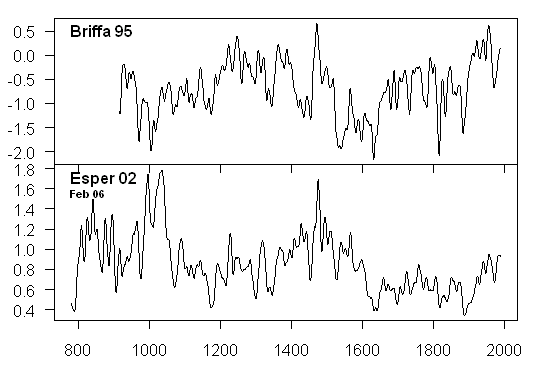It’s interesting that the Hockey Team seems to be able to make spaghetti graphs of world temperature history when they can’t even arrive at a spaghetti graph for the Polar Urals. I posted up the difference between Briffa’s Yamal substitution and the updated Polar Urals ring widths. But before either one, there was Briffa’s Polar Urals temperature reconstruction – which I’ve discussed on many occasions (see Category – Jones et al 1998). Briffa’s Polar Urals reconstruction [Nature 1995] was widely applied in the multiproxy studies and even singled out in IPCC 1995. It stated that 1032 was the "coldest year of the millennium" and that the early 11th century was cold. It was instrumental in supporting the view that everything in the MWP was regional and inconsistent. So how does Briffa’s Polar Urals version compare with the recently disclosed version used in Esper et al [2002]?
Well, the early 11th century is obviously not especially cold – quite the opposite. The correlation between the series is 0.11 (and between the 40-year smoothed version shown below is 0.07). Spaghetti for two, anyone?

Figure 1. Polar Urals. Top – temperature reconstruction from Briffa et al [Nature 1995]; bottom – ring width chronology from Esper et al [2002], as provided in email from Science [Feb 2006].




10 Comments
Esper must not have gotten the memo.
The relative differences between the two LIA periods are apparent too.
I’d like to know what happened to the Polar Urals series data between 1995 and 2006. What does “updated” mean? Apart from the non-correspondence of the low-frequency (they almost look 180 degrees out of phase), there doesn’t seem to be much correspondence between the high frequency shapes, either, except possibly the set of spikes around 1500.
What gives with such a massive change in the shape of the data from time-to-time? Is it so hard to measure ring widths or densities?
In 1998, new samples (russ176) were taken at the Polar Urals site (adding to the previous sample russ021). By “updated” all I meant was that it incorporated the new samples – the new samples were all subfossil and the series still ends in 1990 – I’ll have to use a better label. I think that some of the 1998 samples were taken even higher than the 1990 samples.
Why are they so different? Who the hell knows. Maybe it’s to do with the fact that individual trees are about 50% positive responders and 50% negative responders. (And for all we know, maybe it’s the other way around at least 50% of the time). It could be that there are crossdating problems and that at least one of the sites is messed up.
It’s not just at Polar Urals. I did a similar plot for the updated Jasper/Icefields and it’s not much better in the early portion. One of the things that this points to is that the confidence interval methodology for tree ring chronologies of Wigley, Briffa and Jones [1984] – why is it always the same guys? – which says that the earlier data set had a well-defined “signal” is absolutely bogus.
From a disclosure aspect and this is the type of thing that really irritates me, I think that Briffa had an obligation to report the 1998 results and explain why they were so different from the 1995 results. Why should we be speculating on this 8 years and many multiproxy studies later? Briffa knew what the 1998 results were like. He didn’t like them. But he had an obligation to chin up and report them. BTW Briffa is lead author for this section of IPCC 4AR.
I think we can guess whether the data and methodology is ropey and full of holes in the 4AR: the language will be robust giving no quarter to any doubt about how robust it all is.
The more definite the pronouncement, the less likely it is to be correct, or even mean anything.
“Maybe it’s to do with the fact that individual trees are about 50% positive responders and 50% negative responders. (And for all we know, maybe it’s the other way around at least 50% of the time).”
What? then 50% are negative responders and 50% positive responders.
😉
#6 – I meant to convey Doug Hoyt’s point that maybe the negative responders are sometimes positive responders.
I know Steve, just poking fun at how it read.
Steve’s famous nuance in action.
#4 Your penultimate sentence has the core issue of the whole field, Steve. Briffa didn’t want to do the “chin-up.” The whole field of tree ring multiproxies seems to be contaminated with intellectual cowardice, if not outright speciousness. There are undoubtedly careful, ethical, and courageous workers. I have Rob Wilson in mind, though I’m sure there are others (I don’t know the field to say, and don’t want to give offense here by not noting anyone else). But it seems to me, following your many exposes, that few people want to face the fact that tree ring proxies are not reliable thermometers. The data shift in unpredictable ways because there are far too many unaccountable variables influencing tree rings. Admiting that could, or perhaps would, obviate entire careers. Maybe that’s a confessional show-stopper for these folks. And so instead of honest admissions, we get all sorts of data-pruning and tendentiously macerated analytical methods to produce likely-looking outcomes. And following from that we have the IPCC pushing false conclusions about CO2, and various political groups attacking the basics of prosperity and, in my opinion, rational civility. And we have journal editors corrupted by their own environmental politics into supposing they already know what must be correct.
The whole thing stinks to the sky. I’m no Christian (or even religious) but the analogy of the whitened sepulchres occurs to me. You’ve opened it up, Steve, and the elaborate marble door has exhausted a gust ripe with corruption.
One Trackback
[…] Polar Urals: Briffa versus Esper […]